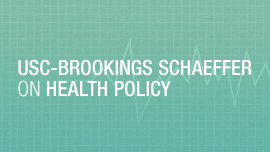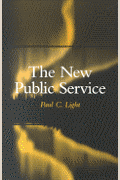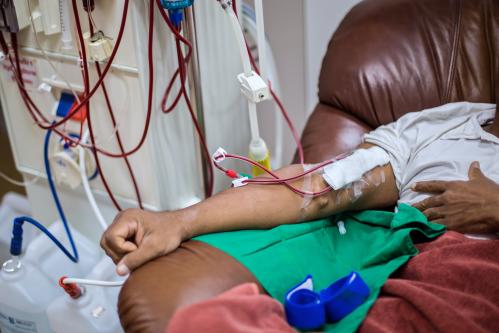What’s the latest in health policy research? The Essential Scan, produced by the Schaeffer Initiative for Innovation in Health Policy, aims to help keep you informed on the latest research and what it means for policymakers. If you’d like to receive the biweekly Essential Scan by email, you can sign up here.
For high-cost specialty drug users, lack of an out-of-pocket cap in Part D has eaten savings from donut hole closure
 Erin Trish, Jianhui Xu, and Geoffrey Joyce found that average annual spending among Medicare beneficiaries taking one of the eight highest cost specialty drugs increased from $18,335 to $33,301 from 2008-2012, and the share of spending while in the catastrophic coverage phase increased from 70 to 80 percent. Though provisions in the Affordable Care Act reduced the burden patients face while in the Part D donut hole, out-of-pocket expenditures in the catastrophic coverage phase have nearly canceled this out for these beneficiaries, according to the analysis in Health Affairs. These findings raise questions as to whether a true out-of-pocket spending cap is needed in Part D. Full article here.
Erin Trish, Jianhui Xu, and Geoffrey Joyce found that average annual spending among Medicare beneficiaries taking one of the eight highest cost specialty drugs increased from $18,335 to $33,301 from 2008-2012, and the share of spending while in the catastrophic coverage phase increased from 70 to 80 percent. Though provisions in the Affordable Care Act reduced the burden patients face while in the Part D donut hole, out-of-pocket expenditures in the catastrophic coverage phase have nearly canceled this out for these beneficiaries, according to the analysis in Health Affairs. These findings raise questions as to whether a true out-of-pocket spending cap is needed in Part D. Full article here.
MSSP ACO savings to Medicare outweighed bonus payments in 2014, unlike in 2013
J. Michael McWilliams found that accountable care organizations (ACOs) participating in Medicare’s Shared Savings Program (MSSP) in 2014 reduced spending by $628.2 million, or $286.9 million on net after shared savings bonuses were paid out, even though 95 percent of the participants were at no risk for losses, according to a research letter published in JAMA. By comparing ACO spending to Medicare spending for similar non-ACO beneficiaries, this study provides a more rigorous look at the success of the MSSP than the initial release of ACO spending data relative to their benchmarks. This result contrasts with his previous finding for 2013, when bonus payments paid to MSSP ACOs outweighed program savings generated. Taken together with the fact that the largest share of reduced spending was attributable to the early entrants that first joined in 2012, these findings call for a renewed look at the ability of upside-only ACO contracts to produce savings for Medicare. Full article here.
Physician consolidation continued from 2013-2015
From 2013-15, David B. Muhlestein and Nathan J. Smith found that the share of primary care physicians in groups of 500 physicians or more grew from 11.4 to 15.9 percent, while the share of physicians in small groups (1-2 physicians) decreased from 22.5 to 19.8 percent, in a Health Affairs study. Because, as the authors note, continued consolidation is likely related to increasing administrative needs and risk-bearing financial arrangements, these findings reiterate the importance of further study on how consolidation impacts health care quality and how much it increases costs. Antitrust enforcement on provider mergers may become more critical as well. Full article here.
CBO predicts that 41-60 percent of hospitals may be in the red by 2025, up from 27 percent today
Tamara Hayford, Lyle Nelson, and Alexia Diorio at the Congressional Budget Office estimated that the share of unprofitable hospitals would increase from 27 percent today to 41-60 percent by 2025 if productivity grows no faster than that in the economy as a whole, and that the average profit margin would fall from the current baseline of 6.0 percent in 2011 to anywhere from 3.3 to -0.2 percent by 2025 in a new working paper. To instead hold profit margins at the 2011 level, hospitals would have to improve their efficiency by an additional 0.2 to 0.5 percent (either by increasing total revenues or reducing total costs). A recent study in Health Affairs from John A. Romley, Dana P. Goldman, and Neeraj Sood, however, did find that hospitals experienced higher productivity growth than previously thought from 2002-11 for certain procedures. The authors of the CBO study suggest that policymakers will require further monitoring of hospitals’ financial performance, particularly in relation to care quality and patient access, to continue to improve alternative payment model reforms and to address any negative impacts from hospital mergers or closures. Full article here.
The Essential Scan is produced by the Schaeffer Initiative for Innovation in Health Policy, a collaboration between the Brookings Institution and the USC Schaeffer Center for Health Policy & Economics.
The Brookings Institution is committed to quality, independence, and impact.
We are supported by a diverse array of funders. In line with our values and policies, each Brookings publication represents the sole views of its author(s).










Commentary
The essential scan: Top findings in health policy research
September 15, 2016